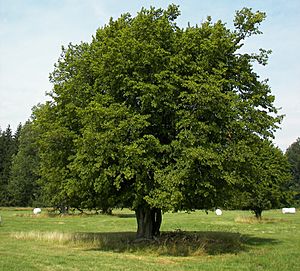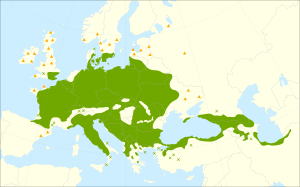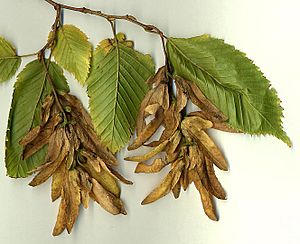European hornbeam facts for kids
Quick facts for kids European hornbeam |
|
|---|---|
 |
|
| Tree in summer | |
| Conservation status | |
| Scientific classification | |
| Genus: |
Carpinus
|
| Species: |
betulus
|
 |
|
| Distribution map | |
The European hornbeam (also called common hornbeam) is a type of tree. Its scientific name is Carpinus betulus. It belongs to the birch family, called Betulaceae. This tree naturally grows in Western Asia and many parts of Europe, including southern England. It likes warm weather to grow well and is usually found below 1,000 meters (about 3,280 feet) in height. You can often find it growing with oak trees, and sometimes with beech trees. It also grows in forests on rocky slopes. Long ago, people sometimes called it 'Yoke Elm'.
Contents
What Does It Look Like?


The European hornbeam is a deciduous tree. This means it loses its leaves in autumn. It is usually a small to medium-sized tree. It can grow between 15 to 25 meters (about 49 to 82 feet) tall. Sometimes, it can even reach 30 meters (about 98 feet). Its trunk often has a wavy or crooked shape.
The bark of the tree is smooth and greenish-grey. It stays this way even when the tree gets old. The buds are small, about 10 millimeters (0.4 inches) long. They lie flat against the twig. The leaves grow in an alternating pattern along the branch. They are about 4 to 9 centimeters (1.6 to 3.5 inches) long. They have clear veins that make them look crinkled. The edges of the leaves are serrated, like a saw.
This tree is monoecious. This means it has both male and female flowers on the same tree. The male and female catkins appear in early summer. The wind helps to spread their pollen. The fruit is a small nut, about 7 to 8 millimeters (0.3 inches) long. It is partly covered by a leafy, three-pointed part called an involucre. This involucre is about 3 to 4 centimeters (1.2 to 1.6 inches) long. The fruits become ripe in autumn.
Uses of Hornbeam Wood
The wood of the hornbeam tree is very heavy and hard. Because of this, it has been used to make tools and for building things. It also burns very hot and slowly. This makes it excellent for firewood. This was a main reason why people used to cut back hornbeam trees. For example, in Epping Forest, hornbeam was a popular tree for a special cutting method called pollarding.
In the past, especially in England, hornbeam trees were often cut using methods like coppicing and pollarding. These traditional ways of managing woodlands are still used today. However, they are mostly for protecting nature, not for selling wood. Hornbeam trees managed this way are common in old woodlands. You can find them in places like south Essex, Hertfordshire, and north Kent. They often make up more than half of the trees in these old forests.
Animals and Hornbeam Trees
The leaves of the hornbeam tree are a food source for some animals. This includes certain Lepidoptera, which are butterflies and moths. For example, the case-bearer moth Coleophora anatipennella eats hornbeam leaves.
Where Hornbeams Grow
There are some famous forests where the European hornbeam is a very common tree. These include:
- Epping Forest in Essex/London, UK
- Halltorp Nature Reserve on Öland, Sweden
How Hornbeams Grow (Ecology)
In England, hornbeam trees seem to prefer soils that are a bit acidic. However, they can also grow in soils that are not acidic. They like soils that have a moderate amount of clay. They do not grow well in soils with too much or too little clay.
Carpinus betulus likes full sun or a little bit of shade. It needs soil that is moderately fertile and has enough moisture. It has roots that spread out wide but are not very deep. If you cut the tree back, new shoots will grow strongly from the stump. Because it handles cutting well and has thick leaves, it is often used in gardening. People use it to make tall hedges and for topiary, which is shaping plants into artistic forms.
The seeds of the hornbeam often do not sprout until the spring of the second year after they are planted. The hornbeam tree produces many seeds. It is very good at growing new trees naturally from these seeds.
Ancient Hornbeam Discoveries (Fossil Record)
Scientists have found three fossil fruits of Carpinus betulus. These fossils were found in samples taken from a deep hole in Poland. They came from freshwater deposits that are from the Middle Miocene period. This shows that hornbeam trees have been around for a very long time!
Growing and Using Hornbeams (Cultivation & Uses)
Carpinus betulus is grown widely as an ornamental tree. People plant it in gardens and parks across northwest Europe because it looks nice.
There are also special types of hornbeam trees called cultivars. Some popular ones are:
- C. betulus 'Fastigiata' or 'Pyramidalis': This tree grows very tall and narrow when it is young. It has become a popular tree to plant along streets in the United Kingdom and other countries.
- C. betulus 'Frans Fontaine': This cultivar is similar to 'Fastigiata' and also grows tall and narrow.
Both the main species and the 'Fastigiata' cultivar have won an important award. This is the Royal Horticultural Society's Award of Garden Merit. This award means they are excellent plants for gardens.
Famous Hornbeam Trees (Notable Examples)
- The Last Tree: This hornbeam was the only tree that survived the terrible Battle of Delville Wood in 1916. It is now protected as part of a memorial in France.
- Lincoln's Hornbeam: This tree was planted by President Lincoln himself. It is located at the United States Botanic Garden in Washington D.C.
Gallery











